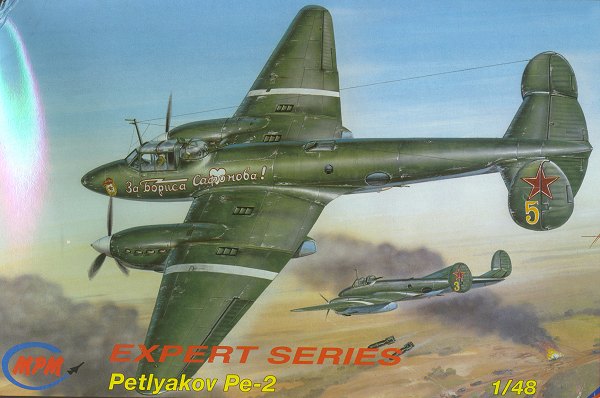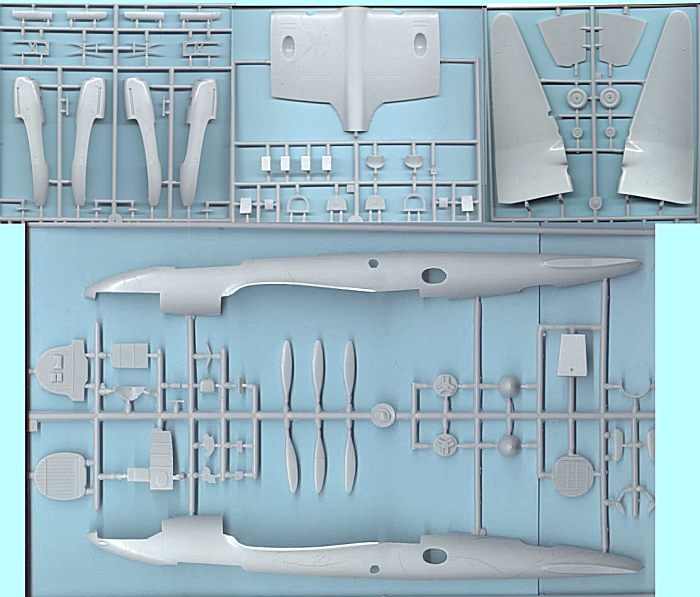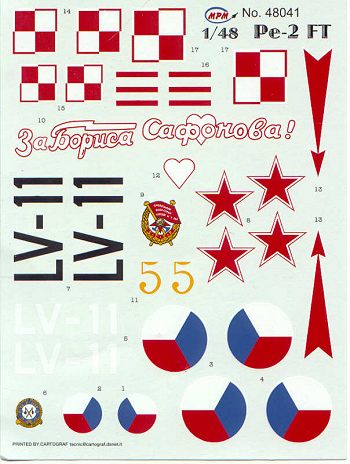
|
KIT: |
MPM 1/48 Pe-2 |
|
KIT # |
48041 |
|
PRICE: |
$34.95 |
|
DECALS: |
See review |
|
REVIEW & |
|
|
NOTES: |
|

|
HISTORY |
One of the great paradoxes of aircraft development is that an airplane can sometimes become very successful in a combat role for which it was not originally designed. There is the Beaufighter, which became an extraordinary torpedo/strike aircraft; the Typhoon, which was a failure in the air supremacy role and an astounding success in the ground attack role; the Mosquito, which became almost a better fighter than it was a bomber; and the Ju-88, designed as a day bomber which found its greatest success as a night fighter.
To this list, one can add the Petlyakov Pe-2, originally designed as a two-seat, turbo-supercharged, high altitude, long range interceptor, which achieved amazing success as a three-seat, low-altitude, short-to-medium range level and dive bomber, built in greater numbers than any Soviet bomber before or since.
Only in the Soviet Union of the late 1930s would the design team that created this airplane have been forced to work under detention, but such was the case with Vladimir M. Petlyakov, who had been arrested during the purges of 1938; his prison was the Special Technical System, run by the NKVD, and his design bureau - KB-100, one of several established for aircraft industry detainees - had the responsibility of designing a twin-engine nigh-altitude long-range fighter. The VI-100, known as Sotka ("little hundred"), first flew on May 7, 1939. By the time it was turned over to the NII/V-VS for testing, priorities had changed and Petlyakov was ordered to rework the VI-100 into a dive bomber that would be known as the PB-100, losing the pressurization and supercharging of the earlier type. The PB-100 was ordered into large-scale production on June 23, 1940. Despite being awarded a Stalin Prize in 1941 for his work on the PB-100, now known as the Pe-2, Petlyakov and his staff were not released from NKVD custody until after the German invasion in June 1941, when they were directed to move production of the aircraft to Kazakhstan.
The first V-VS regiments began to receive the Peshka ("little pet") in the spring of 1941. The aircraft's performance was such that - when the Hurricanes of 151 Wing RAF escorted Pe-2s in fighting around Murmansk in the fall of 1941 - the British pilots had to firewall their throttles to keep up with the Peshka in high-speed cruise.
In 1942, the definitive Pe-2FT (Frontovoye Trebovaniye - "Frontline Request") appeared, with a turret replacing the hand-held dorsal machinegun, with the higher-powered M-105PF engine appearing in 1943. When production ceased in February 1946, 11,427 Pe-2s of all variants had been produced. Peshka had been the backbone of the V-VS bombing forces. With the Yak series of fighters and the Shturmovik, it was one of the three essenial Soviet aircraft of the Great Patriotic War.
|
THE KIT |

This limited-run kit of the M-105PF-powered Pe-2FT by MPM marks the first time this airplane has been produced as an injection-molded 1/48 model. Prviously, the only other kit available in 1/48 was a very good vacuform by Koster Aero Enterprises (which can be built as an early Pe-2, or a mid-to-late series Pe-2FT); in 1/72, the Pe-2FT was first available in a now-elderly offering from Airfix, and a more modern kit produced some five years ago by Italerei.
As is typical with MPM kits, there are mold-release tabs to be cut off prior to commencing construction; fortunately these are all in inside surfaces, and there is no sink in the molding on the outer surfaces as a result of these - there is also a fair amount of flash around certain parts. The cockpit detail comes in cast resin, unfortunately without any molded-in seat belt detail since there are no photo-etch seatbelts. The clear parts are satisfactory and will be better once they have been dipped in Future. The decal sheet provides one V-VS combat machine with interesting markings, and one Polish and one Czechoslovak machine, both post-war. There is no underwing ordnance, which is surprising since the Pe-2FT normally carried four 250 Kg bombs on external braces. (The modeler who has the KAE kit can solve this problem if they decide to turn that kit into a model of the early-version Finnish-operated airplane, which was used for reconnaissance.)

|
CONCLUSIONS |
Overall, this kit looks like it can be built up without any special difficulties by any modeler familiar with limited-run kits. Yours truly has waited a very long time for a 1/48 Peshka, and I can assure you there will be a full-build review here in the not-too-distant future.
If you would like your product reviewed fairly and quickly by a site that has over 900 visits a day, please contact me or see other details in the Note to Contributors.